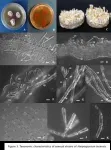(Press-News.org) LEXINGTON, Ky. — Researchers at the University of Kentucky Sanders-Brown Center on Aging are working to develop a pre-symptomatic disease diagnostic tool for Alzheimer’s disease.
“While the need for better treatments is clear, such treatments will not be very meaningful if they are administered after symptoms have onset. By then, Alzheimer’s disease has been ravaging the brain for decades to the point the brain can no longer compensate for the extreme cellular death,” said Mark T. W. Ebbert, Ph.D., Sanders-Brown faculty and an associate professor in the Department of Internal Medicine in the College of Medicine with a joint appointment in the Department of Neuroscience.
Ebbert is leading the research team behind the study titled “Mapping medically relevant RNA isoform diversity in the aged human frontal cortex with deep long-read RNA-seq” that was recently published in Nature Biotechnology.
He is also the principal investigator on multiple awards totaling nearly $5 million from the National Institutes of Health along with grants from the Alzheimer’s Association, the BrightFocus Foundation and PhRMA Foundation that funded that project.
Ebbert’s team includes lead authors Bernardo Aguzzoli Heberle, a Ph.D. candidate at Sanders-Brown, and Jason A. Brandon, Ph.D., a scientist at Sanders-Brown and the Department of Internal Medicine.
The team is using a cutting-edge technique known as long-read sequencing. These technologies allow for a new level of analysis of DNA and RNA, which is the molecule that helps translate genetic code from DNA into proteins.
A single human gene can produce multiple different RNA and protein molecules, called isoforms, allowing it to perform multiple functions. Long-read sequencing helps Sanders-Brown researchers identify and measure these RNA isoforms from a single gene across the entire genome. This also overcomes technical limitations from standard short-read sequencing.
“As a proof of principle, we sequenced aged frontal cortex brain tissue — both healthy brains and brains with Alzheimer’s disease. Our team identified 99 RNA isoforms that were either increased or decreased in Alzheimer’s brains, even when the overall gene activity didn’t change,” said Ebbert. “This shows the importance of understanding isoforms and their unique functions in a gene along with their roles in human health and disease. In fact, we found more than 1,900 genes expressing multiple RNA isoforms related to human disease.”
The team at Sanders-Brown found some of those genes are medically relevant in brain-related diseases, including Alzheimer’s disease, Parkinson’s disease, autism spectrum disorder, and substance use disorder.
“This step in understanding the human genome is exciting, but it is simply not enough. We have so much more to do to understand how individual RNA isoforms are involved in diseases, including Alzheimer’s disease, and how to target them therapeutically. There is so much work to do if we are going to defeat Alzheimer’s disease,” said Ebbert.
The team also discovered five new, complex RNA variants from mitochondrial DNA. Researchers believe this is the first study to identify this genetic material in human tissue.
“Although their expression is low, these genes could serve as biomarkers for mitochondrial function, which play an important role in many age-related diseases. It’s crucial to understand the role these new isoforms play in human health and disease,” said Ebbert.
Sanders-Brown scientists hope these findings can lead to new and more precise targets for disease treatment and diagnosis across a broad range of complex human diseases.
“With this method, we’ve shown there’s potential to specifically target isoforms that are either promoting cellular health or dysfunction rather than treating a gene as a single entity,” said Ebbert. “The analysis can also help us reveal unique signatures in Alzheimer’s disease not detectable at the gene level.”
Researchers say larger studies are needed to better understand the RNA patterns in complex diseases and deep long-read RNA sequencing will be a necessary tool for that work.
“We are also incredibly grateful to the patients who’ve donated to the UK Alzheimer’s Disease Center Tissue Bank,” said Ebbert. “Without their participation, this level of scientific study would not be possible.”
This study brought together a team of researchers from the UK College of Medicine’s Department of Pharmacology and Nutritional Sciences; Department of Pathology and Laboratory Medicine; and Department of Microbiology, Immunology, and Molecular Genetics; Emory University School of Medicine in Georgia; University College of London in the United Kingdom; Cold Spring Harbor Laboratory in New York; and the Mayo Clinic in Arizona.
Research reported in this publication was supported by the National Institute of General Medical Sciences of the National Institutes of Health under Award Number R35GM138636 and the National Institute on Aging of the National Institutes of Health under Award Numbers R01AG068331 and P30AG072946. The content is solely the responsibility of the authors and does not necessarily represent the official views of the National Institutes of Health.
Acknowledgement is made to the donors of Alzheimer's Disease Research, a program of BrightFocus Foundation, for support of this research.
This work was supported by a grant from the Alzheimer's Association 2019-AARG-644082.
END
Sanders-Brown study: Long-read RNA sequencing reveals key gene expressions in Alzheimer’s disease
Researchers at the University of Kentucky Sanders-Brown Center on Aging are working to develop a pre-symptomatic disease diagnostic tool for Alzheimer’s disease
2024-06-06
ELSE PRESS RELEASES FROM THIS DATE:
Women with excess weight as a teen or young adult may have higher stroke risk by age 55
2024-06-06
Research Highlights:
Women with excess weight at age 14 or 31 may have increased ischemic (clot caused) stroke risk before age 55. The same ischemic stroke risk was not found in men.
Losing excess weight after adolescence may not eliminate the stroke risk.
These findings are according to a study conducted in Finland that followed more than 10,000 people from birth into their 50s.
Researchers suggest health care professionals pay attention to overweight and obesity in young people and work with them to promote healthy eating and physical activity from an early age.
Embargoed ...
New glioblastoma treatment reaches human brain tumor and helps immune cells recognize cancer cells
2024-06-06
· Major advance for treatment of deadly brain cancer
· Clinical trial launched at Northwestern to test treatment
· Ultrasound microbubbles open blood-brain barrier to admit chemotherapy and immunotherapy cocktail
CHICAGO --- In a major advance for the treatment of the deadly brain cancer glioblastoma, Northwestern Medicine scientists used ultrasound technology to penetrate the blood-brain barrier and provide a small dose of a chemotherapy and immunotherapy drug cocktail. The study found that this treatment ...
Using oceanography to understand fronts and cyclones on Jupiter
2024-06-06
New research led by Lia Siegelman, a physical oceanographer at UC San Diego’s Scripps Institution of Oceanography, shows that the roiling storms at the planet Jupiter’s polar regions are powered by processes known to physicists studying Earth’s oceans and atmosphere. The geophysical commonalities spanning the 452 million miles between the two planets could even help facilitate an improved understanding of those processes on Earth.
Siegelman first made the connection between our planet and the gas giant in 2018 when she noticed a striking similarity between images of Jupiter’s huge cyclones and the ocean turbulence she was studying. ...
Ohio State develops searchable database for Alzheimer’s research
2024-06-06
COLUMBUS, Ohio – A searchable database is now ready to help study Alzheimer’s disease.
Neuroscience and biomedical informatics researchers at The Ohio State University Wexner Medical Center and College of Medicine created the comprehensive, user-friendly repository.
The free database – known as ssREAD – is outlined in a manuscript published online in Nature Communications.
Alzheimer’s disease is the most common cause of dementia, accounting for up to 80% of cases. An estimated 6.7 million Americans who are age 65 and older are living with Alzheimer's dementia today, according ...
Lifesaving childbirth blood loss intervention is highly cost-effective
2024-06-06
Economic analysis of the E-MOTIVE trial finds that average cost per patient of drape and treatment to save women’s lives incurs minimal additional cost compared with usual care, while significantly improving health outcomes.
The additional cost to achieve the improved outcome could be as little as 30 US cents extra- on average, compared to usual care.
Post-partum haemorrhage currently affects 14m women around the world and leads to 70,000 deaths a year which is equivalent to one woman dying every 6 minutes
A lifesaving package including early detection and bundled treatment for ...
Hidden challenges of tooth loss and dentures revealed in new study
2024-06-06
The hidden challenges faced by people with tooth loss and dentures has been identified by new research from the University of Sheffield.
Improvements in dental care, more people living longer and the social value placed on having a healthy smile has led to people keeping their own teeth longer, but it has also led to an increasing number of people needing some kind of restoration work including crowns, bridges and implants.
Many of these treatments remain unobtainable for most people due to the availability of NHS dentists and the high cost of private dental work. Removable dentures are often the only viable option for anyone experiencing tooth loss with an estimated ...
How medical models can transform agriculture
2024-06-06
Nano-agriculture: Sustainable solutions for global food security
PITTSBURGH—Researchers in the Department of Civil and Environmental Engineering at Carnegie Mellon University are using findings from nanomedicine and digital twin technologies to understand the new field of Plant Nanobiotechnology, address unsustainable agricultural practices, and meet increasing global food demands.
Currently, agriculture accounts for 14-28% of global greenhouse gas emissions and 70% of all freshwater withdraws. This, in addition to a range of other factors from extreme weather ...
World-first study into precision medicine for high-risk childhood cancer yields extraordinary results
2024-06-06
WORLD-FIRST STUDY INTO PRECISION MEDICINE FOR HIGH-RISK CHILDHOOD CANCER YIELDS EXTRAORDINARY RESULTS
VIDEO - https://www.youtube.com/watch?v=bwyugwVwNzc
In a world-first, Australian researchers and clinicians have shown that precision medicine – where treatment is tailored to an individual child’s cancer – leads to significantly improved outcomes in children with high risk cancer.
In a study published this week in the leading international journal Nature Medicine, the researchers found that precision medicine (also called personalised medicine) was shown to be superior to standard or non-guided therapy, both in terms of clinical response and survival.
A staggering ...
Better farming through nanotechnology
2024-06-06
Advanced technologies enable the controlled release of medicine to specific cells in the body. Scientists argue these same technologies must be applied to agriculture if growers are to meet increasing global food demands.
In a new Nature Nanotechnology journal review paper, scientists from UC Riverside and Carnegie Mellon University highlight some of the best-known strategies for improving agriculture with nanotechnology.
Nanotechnology is an umbrella term for the study and design of microscopically small things. How small? A nanometer is one billionth of a meter, or about 100,000 times smaller ...
First-of-its-kind test can predict dementia up to nine years before diagnosis
2024-06-06
Peer Reviewed | Observational study | People
Researchers at Queen Mary University of London have developed a new method for predicting dementia with over 80% accuracy and up to nine years before a diagnosis. The new method provides a more accurate way to predict dementia than memory tests or measurements of brain shrinkage, two commonly used methods for diagnosing dementia.
The team, led by Professor Charles Marshall, developed the predictive test by analysing functional MRI (fMRI) scans to detect changes in the brain’s ‘default mode network’ (DMN). The DMN connects regions of the brain ...
LAST 30 PRESS RELEASES:
Singapore scientists discover lung cancer's "bodyguard system" - and how to disarm it
Bacteria use wrapping flagella to tunnel through microscopic passages
New critique prompts correction of high-profile Yellowstone aspen study, highlighting challenges in measuring ecosystem response to wolf reintroduction
Stroke survivors miss critical treatment, face greater disability due to systemic transfer delays
Delayed stroke care linked to increased disability risk
Long term use of anti-acid drugs may not increase stomach cancer risk
Non-monetary 'honor-based' incentives linked to increased blood donations
Natural ovulation as effective as hormones before IVF embryo transfer
Major clinical trial provides definitive evidence of impacts of steroid treatment on severe brain infection
Low vitamin D levels shown to raise risk of hospitalization with potentially fatal respiratory tract infections by 33%
Diagnoses of major conditions failing to recover since the pandemic
Scientists solve 66 million-year-old mystery of how Earth’s greenhouse age ended
Red light therapy shows promise for protecting football players’ brains
Trees — not grass and other greenery — associated with lower heart disease risk in cities
Chemical Insights scientist receives Achievement Award from the Society of Toxicology
Breakthrough organic crystalline material repairs itself in extreme cold temperatures, unlocking new possibilities for space and deep-sea technologies
Scientists discover novel immune ‘traffic controller’ hijacked by virus
When tropical oceans were oxygen oases
Positive interactions dominate among marine microbes, six-year study reveals
Safeguarding the Winter Olympics-Paralympics against climate change
Most would recommend RSV immunizations for older and pregnant people
Donated blood has a shelf life. A new test tracks how it's aging
Stroke during pregnancy, postpartum associated with more illness, job status later
American Meteorological Society announces new executive director
People with “binge-watching addiction” are more likely to be lonely
Wild potato follows a path to domestication in the American Southwest
General climate advocacy ad campaign received more public engagement compared to more-tailored ad campaign promoting sustainable fashion
Medical LLMs may show real-world potential in identifying individuals with major depressive disorder using WhatsApp voice note recordings
Early translational study supports the role of high-dose inhaled nitric oxide as a potential antimicrobial therapy
AI can predict preemies’ path, Stanford Medicine-led study shows
[Press-News.org] Sanders-Brown study: Long-read RNA sequencing reveals key gene expressions in Alzheimer’s diseaseResearchers at the University of Kentucky Sanders-Brown Center on Aging are working to develop a pre-symptomatic disease diagnostic tool for Alzheimer’s disease







